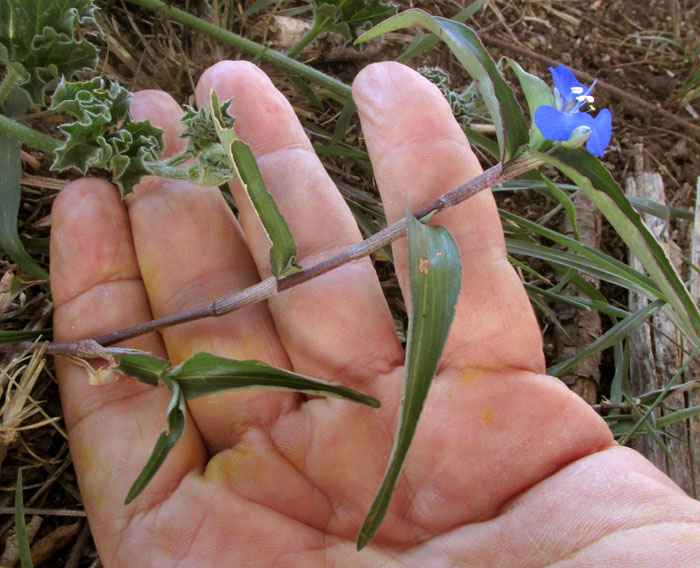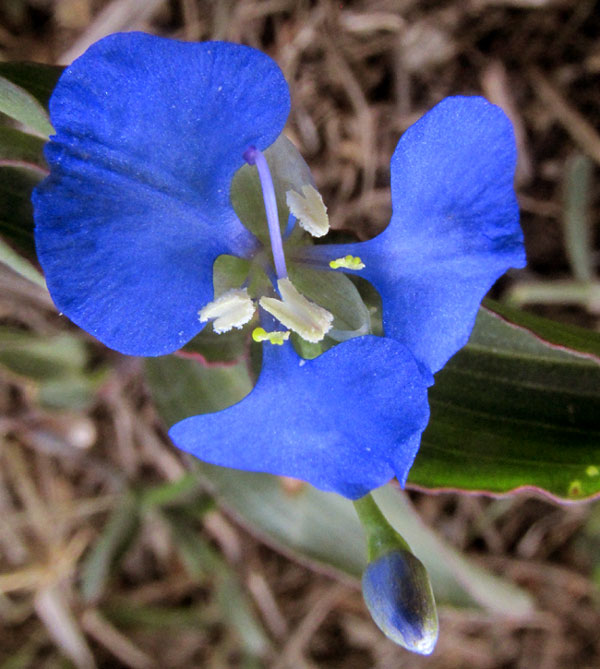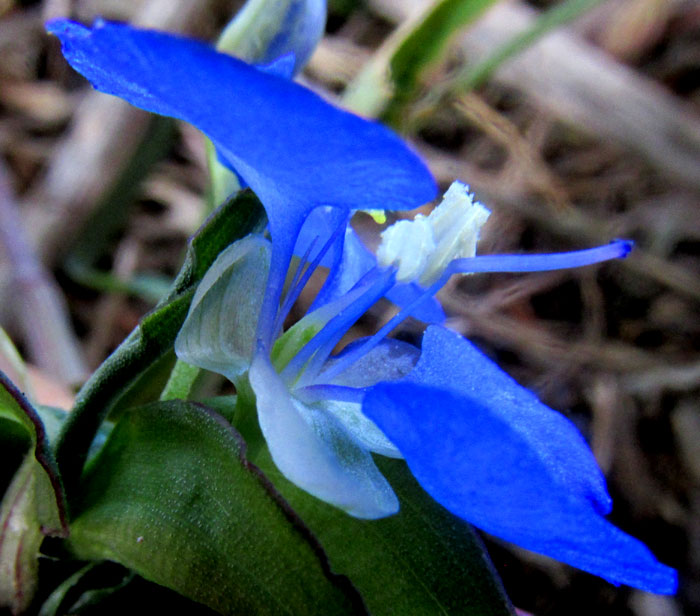Excerpts from Jim Conrad's
Naturalist Newsletter
entry dated August 1, 2022, issued from near Tequisquiapan, elevation about 1,900m (6200 ft), N20.565°, W99.890°, Querétaro state, MÉXICO
SPREADING DAYFLOWER

At the edge of a very overgrazed, eroded slope, a hedgerow of mesquites and other spiny plants offered to a droughty looking assemblage of weeds refuge from the blazing sunlight and heat. Amid the shadows a pinpoint of sky blue caught my eye; It was the little plant pictured above.
In rural Kentucky I grew up with this same species, seeing it in ditch bottoms along the gravel road, even invading the garden during rainy summers. It was a weed and a wildflower, one of the first I learned the name of, and even on my first trip to Mexico in the 60s, then in South America, and even in India, there it was, an old friend with a pleasant smile, quietly at ease in unexpected places. In India it looked even more at home, for the species is native to southern Asia.
It's COMMELINA DIFFUSA, with one of its English names being Spreading Dayflower. "Dayflower," because they say the delicate blossoms last only for a day, and in most weather that's probably right. "Spreading," because many dayflower species stand erect, so already we've noticed an important field mark for knowing the species.
Dayflowers, the genus Commelina of the Spiderwort Family, the Commelinaceae, comprise about 630 species in 50 genera. Worldwide they're mainly tropical, though some extend into the Temperate Zone. They're monocots, like grasses, lilies and orchids, which explains their three petals, instead of the 4 or 5, or multiples thereof, of dicots. A feature of all Spiderwort Family members is that their flowers produce no nectar; The only reward supplied to pollinators is pollen.

Above you see three stamens' white anthers covered with grainy, white pollen being offered to anyone who'll land on a petal and partake. The two yellow items are infertile anthers, or staminodes, maybe adding attraction to certain pollinators. Dayflowers are described as having two upper petals a little larger than the lower one. In the above picture I think the two top petals are the large ones, but really the difference isn't very noticeable.

In the above picture the slender, blue style tipped with a small, knobby stigma points toward the right. A slender, antherless filament, another staminode, rises at the base of the stem-like appendage of the leftmost petal. The three white, petal-like objects below the blue petals are the calyx's sepals. The whole flower arises from a leaf-like bract, or "spathe" a feature of all dayflower species. They're modified leaves forming something like a very narrow scoop that's V-shaped in cross-section. It protects the fragile flower buds before they emerge from the spathe and open.

Above you see how the leaves, instead of having definite petioles, simply narrow at their bases and gracefully wrap around the stem, in the process protecting tender, green shoots, seen above emerging from the leaf axil. It's clear that one way dayflowers manage to produce such delicate features in so many challenging environments is by protecting their most vulnerable parts.
And our plant's shadowy hedgerow environment definitely was challenging with its heat, the extended drought and the daily flocks of sheep that passed by. Even humans have learned that dayflower leaves and shoots taste good in salads, providing a green-bean flavor; Also they can be lightly cooked with other greens in a pot. The flowers, too delicate to amount to more than decoration, can be added to salads, too, and the tiny seeds taste like peas. Our plant was surviving not only because it was hidden in deep shade, but also because of the spininess of surrounding woody plants, plus its stems and leaves were mingled with Wild Squash, whose leaves emit a musky/bitter-smelling odor which sheep might find unpleasing.
In Mexico, traditionally dayflower plants have been cooked with other species to make bathwater for reducing various bodily inflammations. "Commelina diffusa has been used for many years to heal swelling, treatment of urinary tract infection and respiratory tract infections, diarrhea, enteritis, and hemorrhoids," Afroza Afrin Prima and others tell us in their 2018 study entitled "Pharmacological Importance of Commelina Diffuse (Commelinacceae): A Review," writing from Bangladesh.